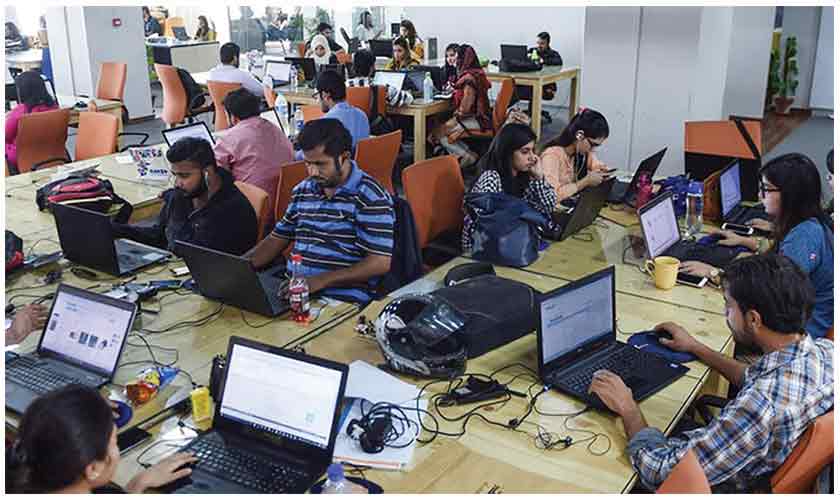Our Terms & Conditions | Our Privacy Policy
The sum of all costs | Special Report

he meanings of wealth (and power) shift from having a lot of dollars to having a lot of petabytes of information,” notes Noah Harari, the famous philosopher, in his latest book, Nexus. He further argues that AI fundamentally differs from everything we have invented so far. It is the first technology in history that can make decisions and create new ideas by itself. That is why there is a need to regulate AI.
Harari’s arguments, some would argue, can be extended to internet connectivity, as connectivity enables the transfer of data — the new wealth. On one hand, internet connectivity has become a crucial necessity in today’s interconnected global economy. On the other, governments and societies are wary of its “misuse” (a subjective term), and try to regulate it.
In Pakistan, unreliable, frequently interrupted and slow internet services are not merely the result of excessive regulations and intentional shutdowns [to perhaps stop its misuse]. These are a consequence also of systemic shortcomings in infrastructure and policy. The country’s connectivity is heavily reliant on submarine cables, with no territorial links due to geopolitical challenges involving its eastern and western neighbours. This vulnerability is compounded by the absence of adequate local infrastructure to support high-speed internet. While a 5G spectrum auction is scheduled for April 2025, over 36 percent of devices in use are still 2G compliant, reflecting the slow pace of technological adaptation. Furthermore, fixed-line connections remain underutilised as most consumers rely on Wi-Fi, which often lacks the capacity to meet modern digital demands. To add to these challenges, the telecom infrastructure is highly susceptible to natural disasters, further destabilising connectivity.
The cumulative impact of these factors not only stifles innovation but also costs the nation billions of dollars annually by affecting consumer services, business efficiency and international investor confidence.
Slow internet hinders businesses, delaying processes such as video conferencing, online transactions and cloud-based operations. This inefficiency disproportionately impacts small businesses and freelancers who rely on digital tools to connect with clients. The Pakistan Software Houses Association estimates that connectivity issues cost the IT sector $300 million annually. Freelancers, a growing economic segment, report income losses of up to 50 percent during outages. Businesses dependent on online communication also suffer reputational damage due to delayed responses and poor service delivery.
Investor confidence is tied to the reliability of a country’s digital infrastructure. Persistent internet disruptions paint Pakistan as an unstable business environment, deterring foreign direct investment. By contrast, regional competitors like India and Bangladesh have invested significantly in digital infrastructure, positioning themselves as reliable destinations for global tech and IT outsourcing. Consistent internet policies and robust connectivity in these countries attract multinational corporations – an area where Pakistan lags behind.
The Overseas Investors Chamber of Commerce and Industry has warned that the internet disruptions risk isolating Pakistan from the global digital economy. Negative perceptions about operational reliability due to frequent shutdowns deter both existing and potential investors. Many potential financers are asking Pakistani start ups to shift to Singapore or Dubai, if they want their ideas to be funded.
Globally, studies reveal that a 10 percent increase in broadband penetration can lead to a 1.38 percent rise in the GDP for developing countries. This statistic, derived from research on broadband’s economic impacts, highlights its critical role in modern economies. High-speed internet supports innovation, reduces operational costs and opens doors to global markets. Taking cue, the government of Pakistan has recently announced its Uraan Pakistan initiative, outlining a comprehensive five-year National Economic Transformation Plan (2024-29) built around “Five Es”: exports; e-Pakistan; environment and climate change; energy and infrastructure; and equity and empowerment. Central to this plan is the e-Pakistan component, which envisions a digital transformation as an enabler for the rest of the four Five-Es goals.
Achieving the ambitious goals of e-Pakistan, such as expanding the freelancing industry; growing the information and communication technology sector; and developing Pakistan’s first unicorn platform, will require a robust and reliable internet network. This network is essential not only for enabling seamless e-governance, digital payment systems and efficient service delivery but also for scaling up the freelancing industry. Without these foundational capabilities, the vision of digital transformation under the Five Es framework will remain unattainable, stalling efforts to create a digital-ready economy and isolating Pakistan from global technological advancements.
Internet policies reflect broader governance challenges in Pakistan. Decisions to throttle speeds or impose shutdowns often prioritise short-term objectives over long-term economic benefits. While national security is a valid concern, arbitrary disruptions signal an inability to balance it with economic security.
The race for technological advancement cannot afford persistent disruptions and policy inconsistencies. For Pakistan, embracing digital connectivity is not an option but a must for economic survival. We missed out benefitting from the previous digital revolution when our peers founded their own ‘Silicon Valleys,’ integrating themselves in the global call centre ecosystem. We are also unable to utilise our full potential of software development and its exports. By not improving internet connectivity, we risk falling further behind in the global digital race.
The writer heads the Sustainable Development Policy Institute. His LinkedIn handle is abidsuleri
[ad_1]
Images are for reference only.Images and contents gathered automatic from google or 3rd party sources.All rights on the images and contents are with their legal original owners.
[ad_2]



Comments are closed.